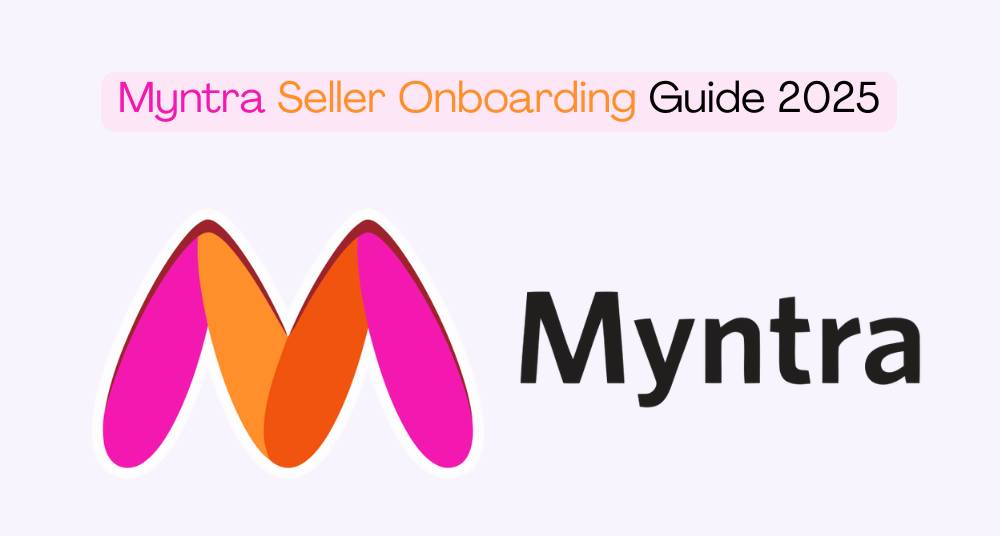If you run a fashion brand in India, selling on Myntra can be the fastest way to scale your visibility, sales, and brand recognition. As one of India’s top fashion marketplaces, Myntra attracts millions of daily shoppers, making it an ideal platform for clothing, footwear, accessories, beauty products, and lifestyle brands.
But unlike Amazon or Flipkart, Myntra follows a curated onboarding model, which means not every seller can list products freely. Your brand must meet certain standards, documentation requirements, and product quality benchmarks to get approved.
This detailed 2025 guide will walk you through:
- How Myntra onboarding works
- Eligibility criteria
- Required documents
- Myntra Partner Portal registration
- Myntra’s brand approval process
- Cataloging, pricing, and logistics
- Myntra commissions & charges
- Best practices to grow sales
- FAQs
Let’s get started.
What Is Myntra Seller Onboarding?
Myntra operates on a brand-driven marketplace model, meaning only curated sellers and brand owners can sell on the platform. Onboarding includes:
✔ Verifying your business & brand
✔ Reviewing product quality
✔ Approving catalog categories
✔ Integrating with Myntra’s Partner Portal
✔ Assigning a category manager
✔ Setting up your store, catalog, and logistics
This process ensures premium quality and maintains Myntra’s reputation as India’s #1 fashion marketplace.
Why Sell on Myntra in 2025?
Selling on Myntra gives your brand several competitive advantages:
1. Exposure to 50+ Million Monthly Shoppers
Myntra leads India’s fashion eCommerce market, especially in:
- Clothing
- Footwear
- Accessories
- Beauty
2. High-Intent Buyers
Users come to Myntra specifically to shop fashion, unlike general marketplaces.
3. Strong Brand Visibility
Myntra promotes premium brands through:
- Myntra Studio
- Sponsor Ads
- Big end-of-season sales
- Brand pages
4. Higher Product Value & Margins
Consumers are willing to pay more for:
✔ Trending styles
✔ Branded apparel
✔ Branded footwear
✔ Premium accessories
5. Full Support From Category Managers
A dedicated category manager helps you with:
- Pricing
- Stock suggestions
- Trend insights
- Visibility opportunities
Who Can Sell on Myntra? (Eligibility 2025)
Myntra accepts sellers who meet the following criteria:
✔ Brand Owners (You own a registered brand)
– Trademark Registered or TM Applied
– Manufacturer or private label brand
✔ Authorized Sellers / Importers
– Must provide brand authorization letter
✔ Manufacturers & Wholesalers
– Should follow Myntra’s quality standards
✔ Premium Resellers
– Limited approval, dependent on brand agreements
Not accepted:
✖ Resellers selling multiple unrelated brands
✖ non-fashion product brands
✖ Used or refurbished goods
Product Categories You Can Sell on Myntra
Myntra accepts sellers in these categories:
- Men’s Clothing
- Women’s Clothing
- Kids’ Fashion
- Footwear
- Bags & Backpacks
- Fashion Accessories
- Watches
- Jewelry (Fashion & Fine)
- Beauty & Personal Care
- Home & Living
Documents Required to Sell on Myntra in 2025
To start your Myntra seller registration, you need:
Business Documents
- GST Certificate
- PAN Card
- Cancelled Cheque
- Address Proof
- MSME Certificate (optional but recommended)
Brand Documents
- Trademark Certificate / TM Application
- Brand Authorization Letter (if not owner)
- Product photos & samples
Bank Details
- Active business bank account
Compliance Documents
- Packaging compliance
- Quality assurance details
- Size chart standards
Step-by-Step Process: How to Sell on Myntra in 2025
Here is the full onboarding journey:
Step 1: Apply for Myntra Seller Registration
You cannot directly create an account like Amazon or Flipkart.
You must reach out through:
✔ Myntra Partner Registration Page
✔ Email to the category team
✔ Agency partners (optional)
✔ Category manager referral
You need to submit:
- Brand profile
- Product catalogue
- Pricing
- Website or Instagram page
- Proof of manufacturing
This helps Myntra evaluate whether your brand fits their marketplace.
Step 2: Brand Review by Myntra Category Team
Myntra’s internal team checks:
- Product uniqueness
- Quality
- Fashion relevance
- Pricing competitiveness
- Branding strength
- Social media presence
- Review ratings (if existing brand)
If approved → You move to onboarding
If not approved → They may ask for improvements or reject
Step 3: Myntra Partner Portal Access
After approval, Myntra gives you access to the Partner Portal, which includes:
✔ Catalog uploading
✔ Inventory management
✔ Order tracking
✔ Payment’s dashboard
✔ Return insights
✔ Sales analytics
Step 4: Sign the Myntra Agreement
You must digitally sign the:
- Seller Agreement
- Commission Structure
- Return Policies
- SLAs (Service Level Agreements)
Step 5: Product Shooting & Catalog Creation
Myntra has strict image guidelines:
- White background
- High resolution
- Model shoots for apparel
- 8–12 product images
- Lifestyle shots for premium categories
You can use:
✔ Myntra-approved studios
✔ In-house photography (must follow guidelines)
Catalog includes:
- Title
- Product description
- Style attributes
- Size charts
- Fabric details
Step 6: Inventory Setup & Pricing Approval
The category manager will help finalize:
- Launch prices
- Offers
- MRP vs Selling Price
- Margin structure
Step 7: Logistics Setup
Myntra supports two models:
Myntra Smart Logistics (MSL)
Myntra collects & delivers products from your warehouse.
Fulfilled by Myntra (FBM)
Your inventory stays in Myntra’s warehouse for faster deliveries.
Step 8: Go Live and Start Selling
Once everything is approved:
✔ Products go live
✔ Inventory syncs
✔ Sales start
✔ Category team monitors performance
Myntra Commission & Charges (2025)
Myntra charges:
1. Commission Fee
Ranges from 18% to 40%, depending on category:
- Apparel: 25%–35%
- Footwear: 20%–25%
- Accessories: 18%–25%
- Beauty: 18%–20%
2. Logistics Fee
Based on weight + delivery zone (₹60–₹120 approx)
3. Return Penalty
If returns exceed category benchmark
4. Advertisement Fee (Optional)
For Myntra Ads (CPC / CPM)
How to Succeed on Myntra (Growth Strategies 2025)
Follow these tips to scale faster:
Maintain High-Quality Product Shoots
Model photos shoot increases:
✔ Conversion
✔ CTR
✔ Premium perception
Keep Inventory Fresh
Upload new styles every 15–30 days.
Participate in Myntra Sales Events
Such as:
- End Of Reason Sale (EORS)
- Big Fashion Festival
- Payday Sale
Leverage Sponsored Ads
Myntra Ads boost visibility significantly.
Optimize Size Charts
Reduces returns by up to 30–40%.
Ensure Fast Dispatch
Slow dispatch affects ranking.
Track Analytics
Watch:
- Return reasons
- Size issues
- Quality complaints
Common Mistakes That Brands Make on Myntra
Avoid the following:
✖ Poor-quality product photos
✖ Overpriced products
✖ Incorrect size charts
✖ Slow delivery
✖ High returns
✖ Not participating in offers
FAQs – Selling on Myntra
1. How much does Myntra charge for onboarding?
Myntra onboarding is free, but you must invest in:
- Product photography
- Packaging
- Inventory
2. Can anyone create a seller account on Myntra?
No, Myntra accepts only curated brands.
3. Do I need a Trademark to sell on Myntra?
Yes — Trademark (TM) or Applied (™) is mandatory.
4. How long does approval take?
7–30 days depending on:
- Brand strength
- Category demand
- Documentation
5. Is GST mandatory for Myntra sellers?
Yes, GST is mandatory.
6. Can I sell handmade products on Myntra?
Only if they meet Myntra’s quality and branding standards.
7. What product categories perform best?
- Women’s ethnic wear
- Men’s casual wear
- Footwear
- Beauty
- Western wear
8. Does Myntra allow COD?
Yes, and it improves conversion.
Final Thoughts
Selling on Myntra in 2025 can be a game-changing opportunity for fashion brands. With the right documentation, high-quality product catalog, competitive pricing, and consistent customer experience, your brand can achieve massive visibility and sales.






What do you think?
It is nice to know your opinion. Leave a comment.